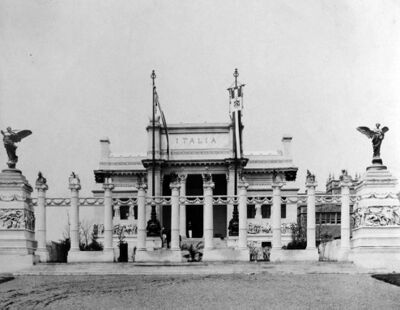Italy
 | |
| Location | Place of Nations |
|---|---|
| No. of Buildings | 1 |
| Construction | |
| Construction Cost | $40,000 ($1.21 million in 2021) |
| Dates | |
| Dedication Day | June 6th, 1904 |
| Architecture | |
| Architect | Giuseppe Sommaruga |
| Dimensions | 90' x 150' |
Italy's pavilion in the Place of Nations was a reproduction of old Roman architecture, trimmed in stately balustrades and a magnificent garden. Situated south of the Administration building, and opposite the Belgium pavilion, the one-story structure fronted International Avenue.
Description
Standing high above the garden level, the pavilion was reached by a broad flight of stairs. Standards crowned with bronzed Victories towered 100 feet on either side of the entrance. A bronze-colored cresting ran around the building, surrounding the lower structures with a dash of red, being an imitation of terra cotta tiles.
The garden which stretched in front of the building was flanked on two sides by a 10-foot wall. The entrance to the pavilion was through a peristyle of beautiful Ionic columns. The walls and colonnade were elaborately treated with porcelain entablatures, and were broken at intervals with pylons which carried spouting fountains. The gardens were enriched by sculpture, rare flowers, and all accessories to present a scene most picturesque.
The pavilion included original manuscripts by Vincenzo Bellini and letters from Giuseppe Verdi.
In the main hall visitors could see portraits of the King and Queen of Italy, and sculptures by Monteverde. The great electrical genius, Marconi, was given recognition in the pavilion.
One salon sported a beautiful interior of stained glass windows made in Milan. This was used for Italian concerts. Two small rooms, where the commissioners' offices were located connected with the salon.
Inside and out, the level of staff work was so artistically executed that many people thought that all the sculptures were from the finest marble.
